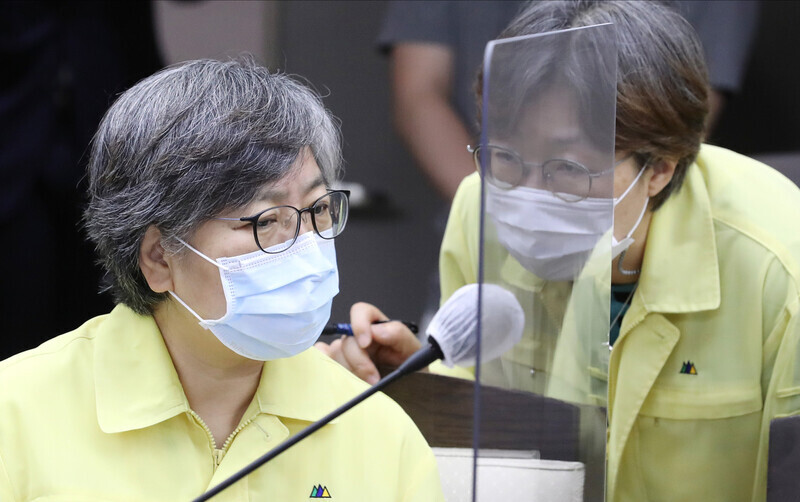hankyoreh
Links to other country sites 다른 나라 사이트 링크
Top priority is reducing daily COVID-19 caseload to below 100, KCDC director says

“The explosive increase in the virus is being suppressed. Our top priority is bringing the scale of the outbreak down to below 100 [new cases per day] so that it’s a level the disease control network and healthcare system can cope with.”
Speaking at a regular briefing on Sept. 2, Korea Centers for Disease Control and Prevention (KCDC) Director Jung Eun-kyeong said, “We’re at a crossroads this week in terms of whether we can stabilize the second outbreak or whether it will grow further.”
“We plead with the public to participate in disease control efforts,” she added. The number of new confirmed cases of the virus that day stood at 267, marking a fourth straight day with cases in the 200 to 300 range. Disease control authorities believe that the number of new confirmed cases per day needs to be brought down to double digits because the situation reaches a “controllable level.”
“We’re seeing cases with unclear transmission routes, and with the outbreak still continuing from exposures one to two weeks ago, we are not expecting [the number of new confirmed cases] to decline rapidly,” Jung said.
“We’re expecting a general trend of decline with repeated rises and falls,” she explained.
As for causes behind the major resurgence of the virus in August, disease control authorities pointed to local infections involving asymptomatic or mildly symptomatic patients among the cumulative patients diagnosed since May; the rise in indoor activity and air conditioner use and the inability to properly ventilate amid an unusually long monsoon season; an increase in gatherings and travel activities amid the school vacation and summer holiday season; and transmission through Sarang Jeil Church in Seoul’s Seongbuk District and a political rally in Seoul on Aug. 15. While the social distancing level has been upgraded, small-scale infection clusters have continued to arise. As of 12 pm on Sept. 2, the cumulative number of patients associated with the Suseo No. 1 apartment complex in Seoul’s Gangnam District had risen to six, according to the KCDC.
The first confirmed cases involved a security worker and resident of the apartment, both of whom work or live in different blocks -- a different situation from another apartment complex in Seoul’s Guro District where the virus spread last month among residents using the same elevator. Additional confirmed cases were associated with Hyemin Hospital in Seoul’s Gwangjin District (10 to date), the Peniel Prayer Room in Seoul’s Nowon District (eight), the Carewill nursing home in Seoul’s Seongbuk District (seven), and a prayer group in Incheon’s Gyeyang District (21).
By Park Da-hae and Seo Hye-mi, staff reporters
Please direct comments or questions to [english@hani.co.kr]

Editorial・opinion
![[Guest essay] Maybe Korea’s rapid population decline is an opportunity, not a crisis [Guest essay] Maybe Korea’s rapid population decline is an opportunity, not a crisis](https://flexible.img.hani.co.kr/flexible/normal/500/300/imgdb/original/2024/0430/9417144634983596.jpg) [Guest essay] Maybe Korea’s rapid population decline is an opportunity, not a crisis
[Guest essay] Maybe Korea’s rapid population decline is an opportunity, not a crisis![[Column] Can Yoon steer diplomacy with Russia, China back on track? [Column] Can Yoon steer diplomacy with Russia, China back on track?](https://flexible.img.hani.co.kr/flexible/normal/500/300/imgdb/original/2024/0430/1617144616798244.jpg) [Column] Can Yoon steer diplomacy with Russia, China back on track?
[Column] Can Yoon steer diplomacy with Russia, China back on track?- [Column] Season 2 of special prosecutor probe may be coming to Korea soon
- [Column] Park Geun-hye déjà vu in Yoon Suk-yeol
- [Editorial] New weight of N. Korea’s nuclear threats makes dialogue all the more urgent
- [Guest essay] The real reason Korea’s new right wants to dub Rhee a founding father
- [Column] ‘Choson’: Is it time we start referring to N. Korea in its own terms?
- [Editorial] Japan’s rewriting of history with Korea has gone too far
- [Column] The president’s questionable capacity for dialogue
- [Column] Are chaebol firms just pizza pies for families to divvy up as they please?
Most viewed articles
- 1Under conservative chief, Korea’s TRC brands teenage wartime massacre victims as traitors
- 2Months and months of overdue wages are pushing migrant workers in Korea into debt
- 3[Guest essay] Maybe Korea’s rapid population decline is an opportunity, not a crisis
- 4[Column] Can Yoon steer diplomacy with Russia, China back on track?
- 5After election rout, Yoon’s left with 3 choices for dealing with the opposition
- 6First meeting between Yoon, Lee in 2 years ends without compromise or agreement
- 7[Column] Behind factional animus of Korean politics, victim mentality festers
- 8‘We must say no’: Seoul defense chief on Korean, USFK involvement in hypothetical Taiwan crisis
- 9[Editorial] Japan’s removal of forced labor memorial tramples on remembrance, reflection and friends
- 10[Guest essay] A society in which old age becomes a burden